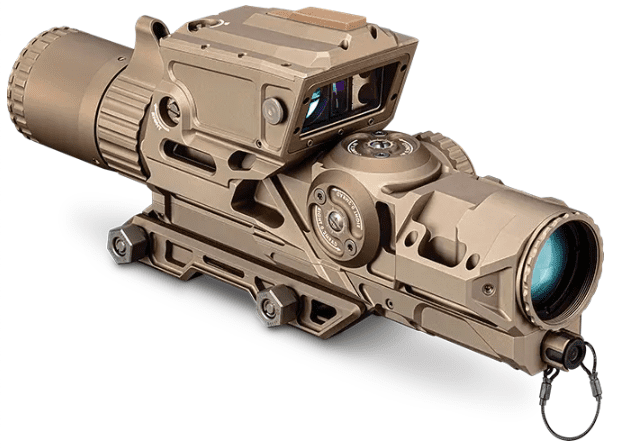Now that we know what rifle the Army has selected to replace the M4 for troops in combat roles, February’s news that Vortex won the XM157 NGSW Fire Control System competition makes a lot more sense. When I first heard “fire control system,” I thought they were talking about the trigger mechanism (fire control group) or maybe a lower receiver design, but that’s not at all what the XM157 is at all. It’s a revolutionary smart optic and communication system that will greatly lower the skill needed to get the most out of the XM5 rifle and the 6.8x51mm hybrid round.
Vortex is understandably proud of their work, and gave the public a nice deep dive on the winning optic system a couple of months ago . . .
The Biggest Problem With Smart Optics
One of the biggest reasons to avoid “smart optics” in the past has been that they’re based on an electronic display. If something goes wrong with the camera or the electronics, or if the battery goes dead, you’ve got an expensive paperweight sitting atop your rifle. If you depend on your rifle to get you out of really crappy situations, you obviously don’t want to risk that happening if it’s at all avoidable.
Fortunately, Vortex thought about that and made sure to design an optic that’s actually an optic, not a digital screen. The “smart” parts only project information (including a self-adjusting reticle) onto a transparent display inside of a normal low-power 1-8×30 variable optic (LPVO) with an etched reticle. If the smart parts fail, a soldier can still use the XM157 like a normal optic and stay in the fight without needing to switch to irons.
Who’s Going To Get It?
It appears that all XM5 rifles will be equipped with this optic. Vortex has a contract for “up to 250,000 optics” which covers all of the “close combat” roles (anyone in line-of-sight of the enemy in a combat role, as they’re closer than artillery and support personnel are) that are going to be issued the new rifle.
While the XM157 next gen fire control system is designed to maximize the utility of the XM5 rifle. It’s programmable to adjust for the ballistics of different loads. That means that, as the Army and SIG SAUER come up with different loads for the weapon, the XM157’s computer can be updated to support them.
It also means that the optic can be used with any rifle, as long as there’s ballistics data for the rifle and rounds. So, at least some people using M4s, DM rifles, and other weapons could get this optic, too.

What about the rest of us? Vortex didn’t give any specific dates on when we could see a civilian version of the optic, but they did say that when they’ve gotten production to the point where it’s satisfying the military’s needs, that they want to start producing something similar for us. It obviously won’t have all of the capabilities described below (civilians wouldn’t use it all, and we wouldn’t want to pay dearly for things we don’t ever use), but it will still be a product many of us want for our own rifles.
What Makes The Optic Smart?
One thing that makes this optic really special is that it has a full display with pixels. It doesn’t just light up a few different spots to give different reticles. Where a pixel is lit up, you see something on top of the optical image from the scope. Where pixels aren’t lit up, you see right through the display.

This gives the shooter a lot of options. Ballistic drop, wind holds, the range to the target (as detected by a built-in rangefinder), menus, augmented reality (including ability to tag objects and see what other soldiers have tagged), waypoints, and basically anything else that the Army wants it to display.
The optic will calculate and adjust for bullet drop, windage, angle, etc. The optic has a number of sensors, including a compass, atmospherics, and a laser rangefinder to get the data it needs to make ballistic calculations and move the digital reticle automatically in fractions of a second to make it a true point-and-shoot system. That means people with less skill can shoot faster and more accurately at the longer ranges the 6.8x51mm round has the energy to work well at.

The optic also knows what zoom level the shooter is at and adjusts accordingly. If you quickly switch it to 1x for an unexpected close-quarters engagement, it automatically simplifies the feature set to give you a simple illuminated circle you’d want at close quarters. Zoom in, and it assumes you have more time to read and use more data, and it gives you that extra data. This makes it a true 0-1000+m optic.
The optic even has the ability to both set and check zero quickly. It shows point of aim, point of impact, and the ability to quickly adjust them to match without wasting a bunch of rounds checking the zero. Armorers will like that, but being able to run a diagnostic in the field is helpful, too.
Finally, it’s designed to be modular and upgradable. There are two attachment points: one where the existing laser rangefinder sits on top, and another one that’s reserved for future upgrades. With a software upgrade and new parts, the optic can serve soldiers far into the future.
Lots Of Smart Friends
Perhaps more importantly, the optic networks with not only other XM157 optics, but computers, smartphones, and even augmented reality visors the Army is developing. Data can potentially come from commanders, satellites, UAVs, and military aviators. It can also be sent to all of those other people who are also in the fight. This gives everyone rapid access to a common operating picture and sensor fusion data, much like the pilot of an F35 or F22 gets.
In the near future, soldiers will be able to look into their optic and see where friends and foes are, even around corners and through walls and terrain. In other words, it gives soldiers near superhuman abilities and sixth senses on the battlefield. Plus, all of that data gets put into the computer to help the soldier get even more accurate shot placement at long ranges.
But It’s Not Too Smart
They obviously can’t get into great detail, but Vortex says the user interface and ease of use was very important. Everyone who has actually handled an XM157 so far says that it’s easy to figure out and easy to get to work with. You don’t need to take a semester-long class to figure out the optic. Most people could look into it, read some basic instructions and be up and running pretty quickly.
The system was shown to a wide variety of military users to make sure that they could get into it and put it to work without getting lost in menus or getting stuck trying to climb an overly steep learning curve. It runs on the same easy-to-find CR123A batteries many other firearms accessories run on.
Perhaps most importantly, the XM157 isn’t heavy or fragile. While Vortex won’t give a specific weight, but it’s lighter than most other options currently in use. It’s also reportedly been tested in brutal environments and shown to survive all sorts of abuse. So, it’s not going to make a soldier’s job harder.
Read More: For those looking to sell similar high-quality gear, Cash for Arms provides a reliable platform for secure and efficient transactions.





So realistically, this thing is going to run probably close to $5k a unit on the civilian market for at least a decade.
I would guess 10k but at least a decade of not longer.
Civilian versions don’t need the ability to link with all the other chapters which will cut the price some.
If so that’s amazing but it’s been a few years since I saw a ballistic calculator integrated into a scope priced out.
The “military industrial complex” is probably 95% civilian owned and operated. And I’m glad they Supply equipment to the military and civilians.
“If something goes wrong with the camera or the electronics, or if the battery goes dead, you’ve got an expensive paperweight sitting atop your rifle.”
Carry a spare.
You didn’t bother to watch the video did you! You can’t fix arrogant.
Better yet, try reading the paragraph following the lines you quoted.
They could put a series of Neodymium magnets on the bolt carrier, a couple of electrical coils on the upper and have a built-in charger that generates power with each shot fired.
And, have face mounted Flinch Detector & buttpad-mounted Pressure Detector to feed operator variables info into the thang for automatic adjustment.
Prdnll…..NO….dead battery still functional scope.
SafeupstateFML …..reference current Sig BDX system in bino/RF/Kestrel to scope ballistic system…..great function….today on hunting/LR/ELR rigs. This development is the next evolution with future designed for.
Brings to mind a comic strip I saw many years ago, seems to me it was MacNelly. The latest tank with all kinds of whizbang tech was on a battlefield. Bogey identified, then background chatter from a gunner reporting ranging, trajectory, and the like for the target. Then this bearded dude in rough clothing runs up holding a rock over his head and mashes the main gun. The gunner says something like, “…or we could just go out there and smack that sucker with a tire iron.”
Wonder how an EMP would affect this new scope. Tech is cool until you lose it.
EMP is going to break a lot more important stuff than the scope electronics, and if you’d been paying attention, you’d know that the scope works fine as a 1-8 scope when there’s no power.
If there’s EMPs going off there’s a lot more at stake then rifle scopes. And a lot more stuff the military uses being damaged too.
“And a lot more stuff the military uses being damaged too.”
Uh, not to mention a whole lot of stuff the non-military peeps use everyday as well…
EMP is the least of worries. The scope meshes and communicates with other “smart” items nearby, and uses lasers to measure distance for range accuracy. This means that the unit broadcasts RF energy and coherent light. A sufficiently naughty enemy might just use such signals to locate and drop munitions on the “smart” armed platoon.
Oopsie!
If a retired cattle rancher can figure that out, let’s hope the Army folks figured it out as well and have a clever solution already deployed.
If you are broadcasting a signal, you can be detected.
I spent a little better than forty years working in various jobs for the Dept. of the Army and the entire bureaucracy serves to keep the cream from rising to the top. The best and the brightest aren’t the ones in charge, they’re usually the ones doing the grunt work because grunt workers have to be fairly competent. I said all that to say don’t count on the people in charge of the programs to have a great deal of foresight or competence.
“…if you’d been…”
Of course I read that part. In fact, it was my point. Lotsa coin invested in something that a garage-built EMP generator could take out, thereby reducing it to a bulky LPVO. I’m not referring to a high altitude nuclear blast. Pull in your horns, boys.
If some enemy can kill expensive electronics with a garage-built EMP generator, why would they pick on rifle scopes? Lots more useful stuff to crap on.
That’s all well and good, but can it convert .doc to .pdf?
That’s for v2.
BTW, you should be using .docx. The new formats have been the standard since Office 2007.
*laughs in raw ASCII text*
Can’t wait to hear the nonsensical shrieking from antis about “scopes of war on our streets.”
Which reminds me of their shrieking over TrackingPoint all those years ago and those ebil guns that will shoot themselves.
It’s already happening, simple scopes are being banned as allegedly “assault weapon scopes” by evilBay (eBay). EvilBay has punished me for selling scopes that eviilBay calls “assault weapon scopes.” I kid you not. Why? Just because the manufacturer (Nikon) put the letters “A.R.” in the name of their scopes as a marketing gimmick, and evilBay uses this to claim they must be “assault weapon” scopes because evilBay is under the delusion that “A.R.” stands for “assault rifle” (rather than Armalite). They’re just ordinary Nikon scopes, which I had on ordinary BOLT-ACTION rifles, not on so-called “assault weapons” (which are banned in my state anyway), but evilBay doesn’t know or care about the facts!
Now I’m stuck with two whole buckets of extra rifle scopes that I can’t sell on evilBay without my account being suspended! I know, there are websites like GB where I can try to sell them, but the other sites don’t get nearly as much traffic as evilBay, so they sell for half the amount on GB (if they sell at all) than they would on evilBay.
Try Amazon or ETSY. Or just go Guns America or GunBroker. They seem to do well enough to compete with EVILE-bay.
THANKS FOR INFOR ALWAYS
I, for one, am glad to hear we still have engineers like the ones at Vortex in the US. I’m not a great supporter of the war monger side of the Deep State Military Industrial Complex, but kind of like the engineers. Peace through strength!
Ask not what you can do for your country, but how much can your country spend from you.
I’d want to know if it has the nutmeg grater attachment. Puts the finishing touch on hot chocolate!
That 49 minute video is full of marketing blather. Takes 4 minutes just to even begin phrasing the first “technical” question. Pro tip: Skip forward if blue shirt-glasses is not on screen, and 3/4 of what he says if marketing blather too.
I’m pleased to finally read something on TTAG that recognizes the difference between “CLOSE COMBAT” verses “CLOSE QUARTERS COMBAT.”.
How about I use an ACOG with Fiber Optic and Tritium (No batteries) with the ACSS Aurora Reticle and we will see who can get more hits on a run and gun course and at distance, out to meters 400 meters. A LPVO is needlessly complicated for infantry and more prone to breakage, especially when coupled to all the electronics this thing has. An battery free ACOG costing $1200 vs this “Wonder Optic costing $5k to $15k. If you need to fiddle with dials, carry more batteries and turn it on, its a failure.
The Army keeps looking for ways to use technology to make up for poor training and lack of practical field craft. Shooting on a square range at known distance pop-up targets is not real world anything. Invest in your people and give them robust, low maintenance solutions to real problems and you will win.
The only interesting electronic tech that I have seen that might be good for “Special Troops” is the Steiner CQT sight with combines a red dot and a Thermal sight with 1x magnification. Downside is that it uses 2 x CR123 batteries. However it would be great to spot troops who are camouflaged in close proximity to the user and since its a thermal, it can be used in daylight/indoors and at night with no starlight or moonlight needed. Cost is $10k, so its not for everyone.
But 5.56 is EXPENSIVE so the 11B will get 100rd/year (this was 1986 “buildup).
I don’t think I want an IoT optic… or any IoT object, on me or near me if I actually need a combat rifle.
I don’t care if that network is “private”. The idea is stupid.
But the IoT scopes can properly identify protected class people and ensure that the wrong people don’t get shot. Just think, a rifle that only fires accurately at what the current federal administration deems to be the threat.
Anyone know the country of origin for manufacturing this thing? If it’s in the article I apologize for missing it.
USA, mostly.
DOD doesn’t buy stuff like this from overseas other than select cases from allied countries and Vortex is a US brand, based in Wisconsin IIRC. Vortex’s marketing has been in a bunch of articles about this thing, “The XM157 is built around a 1-8×30 LPVO featuring a glass-etched reticle on lenses made entirely in the U.S.”. Now rules of English suggest that this means that the lenses are made entirely in the US, but given the level of of competency in English that’s the average in the US for the last 20 years this could be a misplaced modifier and they intend to refer to “The XM157”.
Based on how this generally works, I’d guess some parts are foreign, probably from Japan. Though if they’re grinding and etching lenses in the US, which is a costly business, it might well be 100% US made.
Regardless, you’re fairly well assured this thing is governed by ITAR, meaning that it’s mostly US made.
Will robots be able to learn how to use it ?
“which covers all of the “close combat” roles (anyone in line-of-sight of the enemy in a combat role, as they’re closer than artillery and support personnel are) that are going to be issued the new rifle.”
So the girl soldiers (useless/dead weight) aren’t getting these?
Awesome article Jennifer Sensiba. Thanks for the great information. GOOD JOB !!!
I’ve been following this for a while, so I knew it was coming. Good job on the article. Owning a Vortex Venom and a Vortex Sparc, I have to say I’m pretty pleased with their products. Neither have given me any problems, and 3 MOA and 2 MOA are perfectly acceptable accuracy for the ranges I shoot at (98% 100 yards or less).
If and when a civilian version is released, I will certainly look at it.
Make it solar-charged and include a solar-failsafe backup which will still project the red dot if the battery fails or even if there’s no battery at al, like most Holosun and some Sightmark red dot sights. Sunshine shouldn’t be a problem in the places the US Army is planning to fight, because judging from the FDE color of the optic, the rifle, and everything else the US Army has been buying lately, they expect all our future wars will be in sunny Middle East deserts, just because God put “our” oil under “their” sand!
I know, I know, this “fire control system” draws a lot more power than just a simple red dot, because its laser rangefinder, ballistic computer, and the IoT communications technology in it (which broadcasts a shout-out to any enemy, “Heads up! There’s a platoon of US soldiers approaching! Prepare to kill them!”), so solar wouldn’t be enough to power all that. But that’s part of the problem.
I can already imagine that starting in 2023, the standard combat load for an 11-Bravo will include only 100 rounds of 6.8 x 51mm ammo (because the new ammo weighs twice as much as 5.56 and is twice as bulky) but 210 batteries for all their tech gear!
It will be like that Tom Cruise movie “The Edge of Tomorrow,” where if a soldier’s batteries die, he’s useless on the battlefield.
The XM157 Next Generation Fire Control System for the XM5 Rifle, is a revolutionary design that incorporates the best attributes of the XM29 OICW, XM8, M16A5 and the M4 carbine into one package. The XM157 NGFCS is designed to maximize the lethality of the XM5 Rifle at all ranges. Credit essay writing service cheap
“The “military industrial complex” is almost certainly a large proportion of civilian owned and controlled by civilians. It’s great that they provide equipment to military personnel as well as civilians. I have a lot of know-how.
To lay it out plainly, the thing that matters is the length. At an essential, comprehensive level, Black & Yellow Varsity Jacket are weighty and boiled down to the hip or longer, while coats are light and stop at hip length, however, there are a lot of variations that ride the line between coat and coat.
The corporation Tax Awareness Programme was introduced by the Ministry of Finance of the United Arab Emirates in the months before corporation tax was implemented. The programme teaches the business community about Corporate Tax Uae 2023 legislation through online and hands-on seminars.
How does the XM157’s ability to adjust for variables like bullet drop, windage, and range impact the overall accuracy and speed of shooting with the 6.8x51mm round, especially at longer ranges?
Vintage alcohol exudes a timeless charm, offering connoisseurs a journey through history in every sip. These aged libations, often crafted decades ago, boast unique flavors and complexities, a testament to meticulous craftsmanship. Whether it’s a well-matured whiskey, an aged wine, or a vintage champagne, each bottle tells a story of bygone eras. The rarity and scarcity of these beverages contribute to their allure, creating a niche market for collectors and enthusiasts. Embracing vintage alcohol isn’t just about taste; it’s a celebration of tradition and a connection to the past, making each pour a luxurious and memorable experience. Cheers to the classics! 🍷🥃
Well DAMN … why dont we just attach the whole damn toolbox to the top and front of the gun … ??? Whatever happened to trained marksmanship? I’m sure it will all be somehow made in China like most everything else Vortex produces.